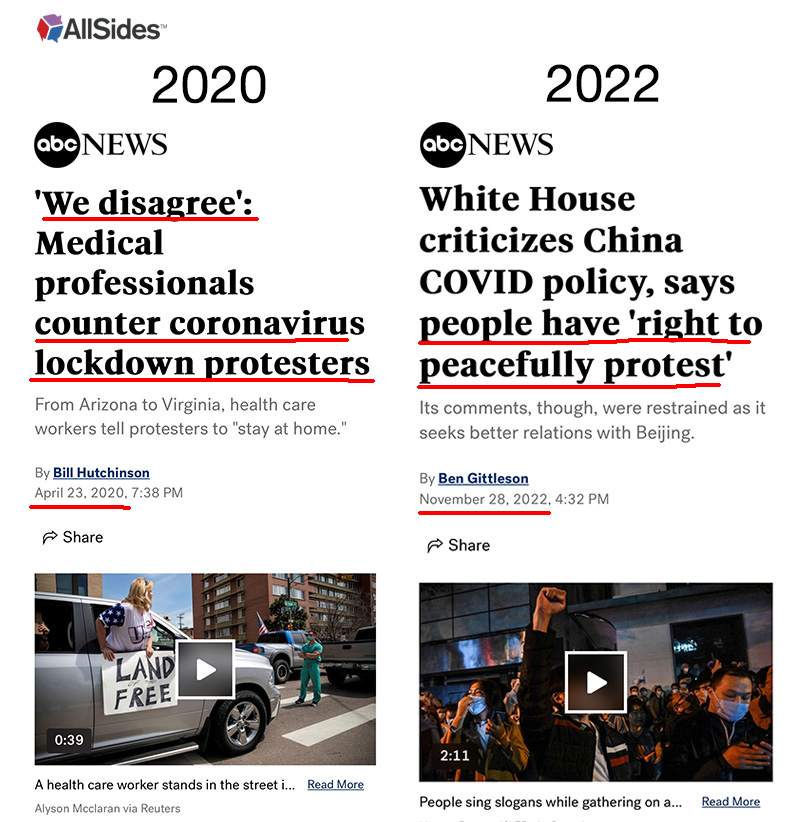Is Media Coverage of Chinese Anti-Lockdown Protesters Biased?

Anti-lockdown protests in cities across China have garnered media attention in the Western world in recent weeks. Yet the coverage of anti-lockdown protesters in China has taken a very different angle than it took in 2020, when anti-lockdown protests occurred in the U.S. and other Western nations, revealing media bias by slant.
Headlines and coverage from Vox (Left bias), ABC News (Lean Left), The Guardian (Lean Left bias), and Sky News (not rated) were very different in 2020 versus now.
Slant is when the media plays up or downplays certain elements of a story. In the case of 2020 protests, many media outlets played up voices concerned about the virus spreading, labeled protesters as conspiracy theorists, and downplayed concerns protesters had around authoritarianism, their livelihoods being threatened, the mental health impacts of social isolation, and more.
Some Vox articles took contrasting approaches toward anti-lockdown protesters in 2020 versus 2022. Back then, a Vox writer argued white privilege was a culprit in the protests, running the headline, “The whiteness of anti-lockdown protests.” Vox stated that “ignorance, privilege, and anti-black racism is driving white protesters to risk their lives,” calling protesters who carried signs such as “No Liberty. No Life.” purveyors of “far-right theatrics.”
Nearly three years later, a different Vox writer quotes a professor who says Chinese people are protesting due to concerns over how they have “lost their source of income” due to lockdowns. Back in 2020, Vox downplayed this concern, writing, “To be fair, some protesters have expressed a deep financial need to return to work, to keep their lights on and a roof over their heads, which is understandable … But these protests are also attended by Trump supporters who have been convinced by conservative media pundits ... that the virus is actually less deadly than the seasonal flu and that “this was not and is not a pandemic.””
Another 2020 Vox article led with, "Wired’s Emma Grey Ellis called [anti-lockdown protests] an “American mess,” describing them as “a modern permutation of an identity crisis with roots very deep in America’s individualist history.”" The article goes on to link protesters to extremism, stating, “Activists in Michigan displayed anti-Semitic signs and wore swastikas outside the state capitol during an anti-lockdown protest….”

In 2020, ABC also highlighted voices condemning anti-lockdown protests, running the headline, “‘We disagree’: Medical professionals counter coronavirus lockdown protesters.” This year, an ABC headline highlights voices from the White House criticizing China’s lockdowns and saying people “have the right to peacefully protest.”
ABC did run a 2020 article on Michigan anti-lockdown protesters that was balanced — it equally quoted the governor (in favor of lockdowns) and protesters. Other ABC articles, however, focused on how anti-lockdown voices were linked to the right and to conspiracy theories, such as the piece, “How the pro-Trump message machine is seizing on anti-lockdown fever.”
Sky News did much the same, calling UK protesters "coronavirus conspiracy theorists" in 2020, but calling Chinese protesters "anti-lockdown protesters" in 2022. While the 2020 piece highlighted links to conspiracy theories, the 2022 piece highlights that Chinese protesters had endured "extreme restrictions for months." Extreme restrictions were a reality in both cases, albeit to varying degrees, but only highlighted in one case.
Sky News did, however, highlight a voice, author Douglas Murray, who claimed the “double standard” is very “clear” as Chinese protesters have received media support and Western protesters didn't.
The Guardian is another outlet that highlighted voices against the anti-lockdown protesters back in 2020, running the headline, “US anti-lockdown rallies could cause surge in Covid-19 cases, experts warn.”
Like Vox, it also emphasized that protesters seemed to be conservative, noting that “Trump defended the anti-stay-at-home protesters, many of whom have not followed federal or state social distancing guidelines.” Fast-forward to this year, when The Guardian Editorial Board had a very different tone on Chinese anti-lockdown protesters, penning an op-ed titled, “The Guardian view on China’s protests: zero Covid, maximum frustration.” The board writes, “China’s people should be free to discuss the decisions being made and the leaders who impose them, and to protest against them.”
The tone in the media, and which voices they have highlighted, has possibly swung because vaccinations and immunity mean they believe the threat of COVID-19 in 2022 is mitigated, and lockdowns are no longer necessary, while they believed lockdowns were necessary back in 2020. It is possible for people to change their minds, and to see anti-lockdown protests as bad back then, but good now.
However, those who have always been anti-lockdown would likely argue the science on whether or not lockdowns are effective overall is in dispute, while the negative effects of lockdowns on a population were the same in 2020 as they are today: loss of income, social isolation, learning loss, and mental health stressors. The concerns of protesters, whether Chinese or American, are largely the same, yet treated differently. To downplay their concerns in one aspect but not another represents a bias.
They may also point out that media outlets had a very different tone about those who defied lockdown orders in 2020 depending on the political causes they supported. Anti-lockdown protests occurred in April 2020. Black Lives Matter protests erupted just one month later, in May 2020, following the killing of George Floyd. Some outlets — which just one month previously had been critical of or highlighted people critical of those gathering to protest lockdowns — suddenly took a much softer tone depending on who was gathering. They instead highlighted voices saying BLM protests were necessary, while simultaneously running articles condemning Donald Trump and his supporters for holding rallies. (We stopped seeing coverage of anti-lockdown protests around this time). Back then, I compiled a roundup of examples of these instances of bias, which you can see here. Note the time stamps on the articles below.
In sum, little has changed: partisan media takes a very different tone about protests depending on who is protesting and why they are protesting. When U.S. conservatives or people in other Western nations protested against lockdowns earlier in the pandemic, the left-leaning media was critical; when Chinese citizens protest similar actions of the Chinese government — albeit measures that have been much stricter and lasted much longer — left media is more supportive.
China’s lockdowns have lasted much longer and been much more strict than lockdowns in the U.S. While there appears to be no comprehensive record of lockdown length by city, county or state in the U.S., American authorities were issuing lockdowns for at least a year, while China’s lockdowns have lasted nearly three years.
RELATED: How Is China's Government Responding to Anti-Lockdown Protests?
The effects of lockdowns are always very similar, with governments restricting movement, banning gatherings of a certain size, ordering businesses to shut down, and implementing mandatory COVID testing and/or masking. Lockdowns, no matter their length, always mean confinement — people cannot leave their homes, work, see loved ones, go to the gym, travel across state lines, or engage in leisure activities.
In some parts of the U.S., playgrounds were roped off and hiking trails were closed, so many Americans could not exercise either.
China’s lockdown enforcement has been much more intense. News sources on both left and right have reported that authorities in some Chinese cities welded doors to apartment buildings shut to prevent residents from leaving, and that police have at times responded to lockdown protests with violent force. In addition, activists are blaming a recent deadly fire on the lockdowns and accusing the Chinese government of hiding the true death toll.
Some would argue that these differences make comparisons of the two situations moot. But though details of the lockdowns themselves are different, the protesters likely share the same sentiment: opposition to the restriction of personal freedom. But that doesn't mean media treated them the same way.
Julie Mastrine is the Director of Marketing and Media Bias Ratings at AllSides. She has a Lean Right bias.
This piece was reviewed by Henry A. Brechter, Managing Editor (Center bias), Joseph Ratliff, Daily News Editor (Lean Left), and Clare Ashcraft, Bridging and Bias Assistant.


April 24th, 2024

April 24th, 2024

April 22nd, 2024